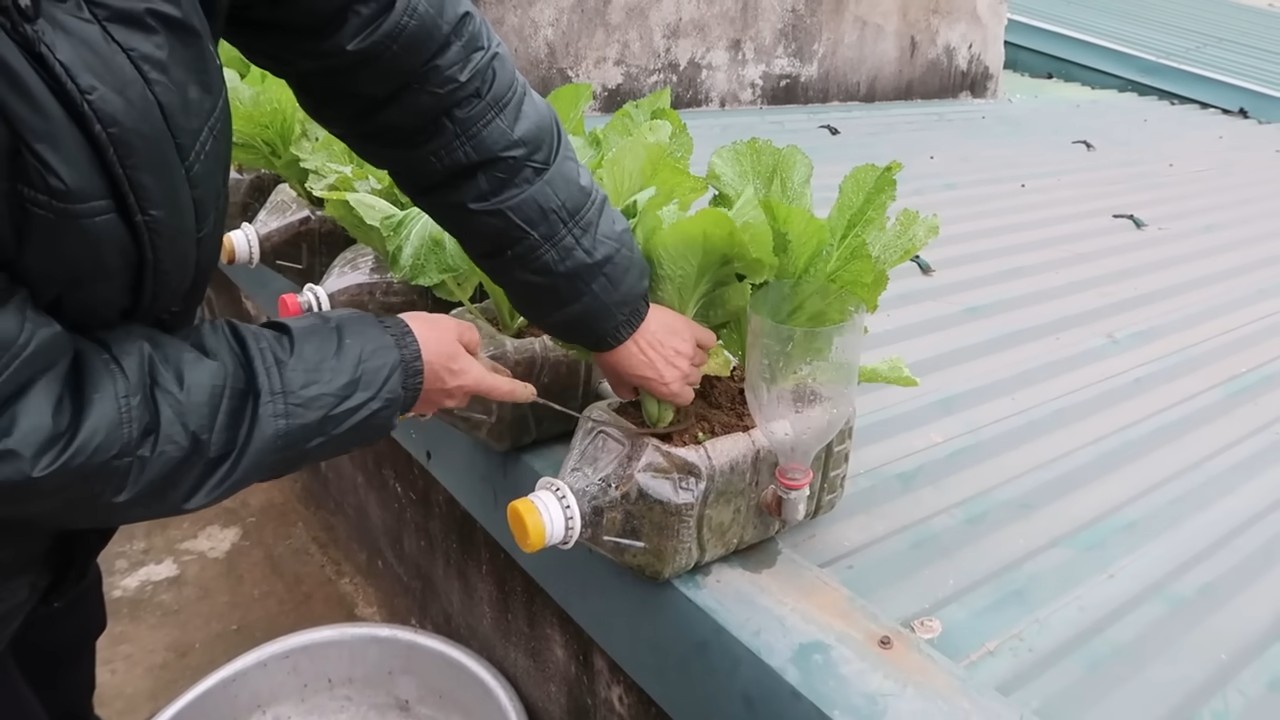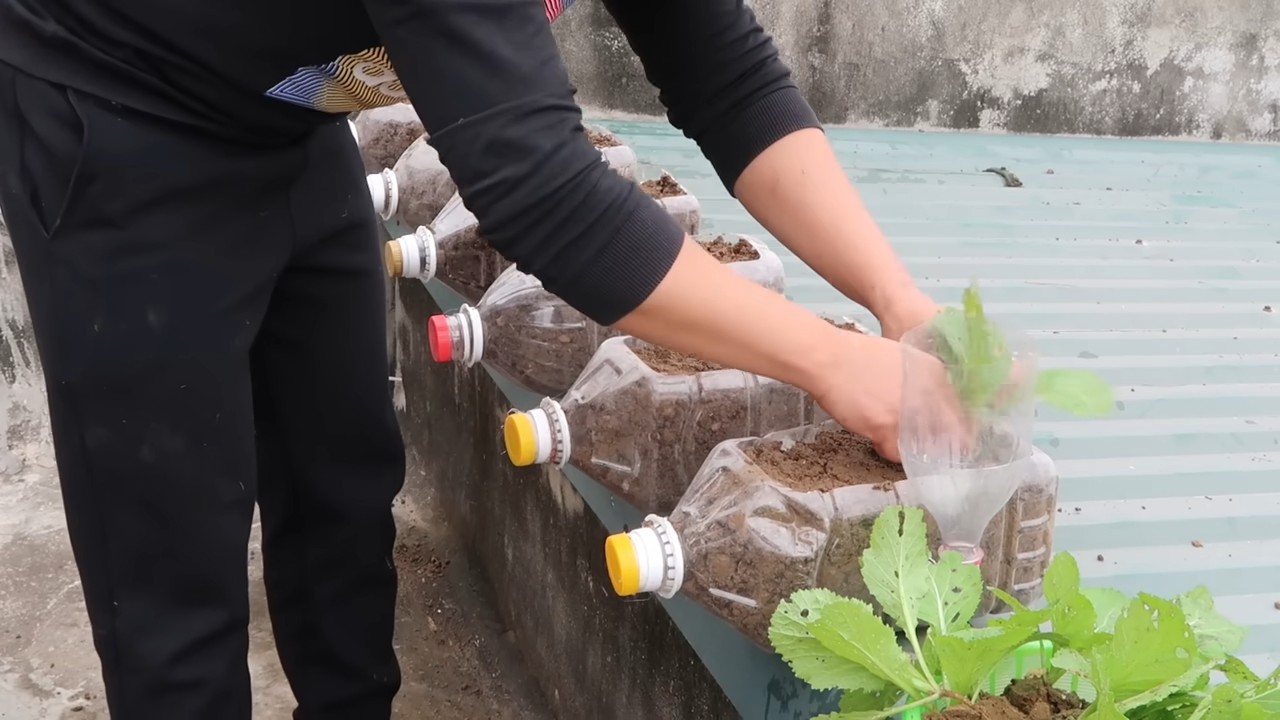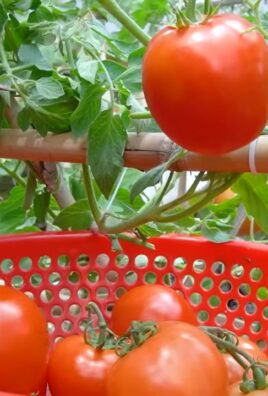Grow vegetables at home, even if you think you don’t have a green thumb! Have you ever dreamed of stepping into your backyard and picking fresh, juicy tomatoes for a salad, or snipping fragrant herbs to season your dinner? It’s more achievable than you might think, and this DIY guide is your ticket to making that dream a reality.
For centuries, cultivating our own food has been a cornerstone of human civilization. From ancient Roman kitchen gardens to the victory gardens of World War II, growing vegetables at home has provided sustenance, fostered community, and connected us to the earth. Today, with concerns about food security and the desire for healthier, more sustainable living, the practice is experiencing a vibrant resurgence.
But let’s be honest, getting started can feel overwhelming. Where do you begin? What if you have limited space? What about pests and diseases? That’s where these clever DIY tricks and hacks come in! I’m going to share my favorite tips and techniques for successfully grow vegetables at home, regardless of your experience level or the size of your garden. From repurposing everyday items to creating efficient watering systems, these simple solutions will help you maximize your yield, minimize your effort, and enjoy the incredible satisfaction of harvesting your own homegrown goodness. So, grab your gardening gloves, and let’s get started!

DIY Home Vegetable Garden: From Seed to Supper!
Hey there, fellow garden enthusiasts! I’m so excited you’re thinking about growing your own vegetables. Trust me, there’s nothing quite like the taste of a tomato you’ve nurtured from a tiny seed. It’s rewarding, healthy, and surprisingly easy to get started. This guide will walk you through everything you need to know to create your own thriving vegetable garden, even if you’ve never planted anything before!
Choosing Your Location and Vegetables
Before we get our hands dirty, let’s plan! The success of your garden hinges on two key factors: location and the types of vegetables you choose.
* Sunlight is King (or Queen!): Most vegetables need at least 6-8 hours of direct sunlight per day. Observe your yard throughout the day to see where the sun shines the longest. South-facing areas are generally best.
* Soil Matters: Good drainage is crucial. You don’t want your plants sitting in soggy soil. If your soil is heavy clay or very sandy, you’ll need to amend it (more on that later!).
* Water Access: Easy access to a water source is essential. Lugging watering cans across the yard gets old fast!
* Consider Your Climate: Choose vegetables that thrive in your local climate. Your local extension office (a quick Google search will find it!) is a fantastic resource for this. They can provide information on planting dates and recommended varieties for your area.
* Start Small: Don’t overwhelm yourself! Begin with a few easy-to-grow vegetables like lettuce, radishes, tomatoes, zucchini, or herbs.
* Grow What You Love to Eat: This seems obvious, but it’s important! There’s no point in growing kale if you hate kale.
Preparing Your Garden Bed
Now for the fun part – getting our hands dirty! Whether you’re using a raised bed or planting directly in the ground, soil preparation is key.
* Testing Your Soil: A soil test is highly recommended, especially if you’re unsure about your soil’s composition. You can purchase a soil testing kit online or through your local extension office. This will tell you the pH level and nutrient content of your soil, allowing you to amend it accordingly.
* Clearing the Area: Remove any grass, weeds, rocks, and debris from the area you’ve chosen for your garden. A shovel, hoe, and some elbow grease will do the trick.
* Amending the Soil: This is where we improve the soil’s texture and nutrient content.
* Adding Compost: Compost is your best friend! It adds organic matter, improves drainage, and provides essential nutrients. Spread a 2-4 inch layer of compost over the garden bed and work it into the soil with a garden fork or tiller.
* Other Amendments: Depending on your soil test results, you may need to add other amendments like:
* Lime: To raise the pH of acidic soil.
* Sulfur: To lower the pH of alkaline soil.
* Fertilizer: To provide specific nutrients that your soil is lacking. Choose a fertilizer formulated for vegetables.
* Tilling or Digging: Once you’ve added your amendments, till or dig the soil to a depth of 8-12 inches. This will loosen the soil and allow plant roots to penetrate easily.
* Raking: Rake the soil smooth to create a level planting surface.
Starting Seeds Indoors (Optional)
Starting seeds indoors gives you a head start on the growing season, especially for vegetables that require a long growing period, like tomatoes and peppers.
* Choosing Your Seeds: Select high-quality seeds from a reputable source. Read the seed packet carefully for information on planting depth, spacing, and days to maturity.
* Seed Starting Mix: Use a seed starting mix, not regular potting soil. Seed starting mix is lighter and provides better drainage.
* Containers: You can use seed starting trays, peat pots, or even recycled yogurt containers (just make sure to poke drainage holes in the bottom!).
* Planting the Seeds: Follow the instructions on the seed packet for planting depth and spacing. Gently press the seeds into the soil and cover them lightly with seed starting mix.
* Watering: Water the seeds gently with a spray bottle or watering can. Keep the soil consistently moist, but not soggy.
* Light: Seeds need light to germinate. Place the seed starting tray under grow lights or in a sunny window. If using a window, rotate the tray regularly to prevent the seedlings from leaning towards the light.
* Warmth: Seeds germinate best in warm temperatures. Use a heat mat to keep the soil warm.
* Hardening Off: Before transplanting your seedlings outdoors, you need to “harden them off.” This gradually acclimates them to the outdoor environment. Start by placing the seedlings outdoors in a sheltered location for a few hours each day, gradually increasing the amount of time they spend outdoors over a week or two.
Planting Your Vegetables
Now it’s time to get those plants in the ground!
1. Check the Weather: Make sure the weather is suitable for planting. Avoid planting on days that are too hot, cold, or windy.
2. Dig the Holes: Dig holes that are slightly larger than the root ball of your plants.
3. Remove the Plants from Their Containers: Gently remove the plants from their containers. If the roots are pot-bound (tightly circling the root ball), gently loosen them with your fingers.
4. Plant the Plants: Place the plants in the holes and backfill with soil. Gently firm the soil around the base of the plants.
5. Water Thoroughly: Water the plants thoroughly after planting. This will help settle the soil and encourage root growth.
6. Mulch: Apply a layer of mulch around the plants. Mulch helps retain moisture, suppress weeds, and regulate soil temperature. Straw, wood chips, or shredded leaves are good choices for mulch.
Caring for Your Vegetable Garden
Congratulations, you’ve planted your garden! Now comes the ongoing care to ensure a bountiful harvest.
* Watering: Water your plants regularly, especially during dry periods. The best time to water is early in the morning. Water deeply and less frequently, rather than shallowly and often. Aim to water the soil, not the leaves, to prevent fungal diseases.
* Weeding: Weeds compete with your vegetables for water, nutrients, and sunlight. Remove weeds regularly by hand or with a hoe.
* Fertilizing: Fertilize your plants regularly with a fertilizer formulated for vegetables. Follow the instructions on the fertilizer package.
* Pest and Disease Control: Keep an eye out for pests and diseases. There are many organic and non-organic options for pest and disease control. Your local extension office can provide recommendations for your area.
* Support: Some vegetables, like tomatoes and cucumbers, need support to grow properly. Use stakes, cages, or trellises to support these plants.
* Pruning: Prune your plants as needed to remove dead or diseased leaves and to encourage air circulation.
Harvesting Your Vegetables
This is the moment you’ve been waiting for! Harvesting your own vegetables is incredibly rewarding.
* Know When to Harvest: Each vegetable has its own optimal harvesting time. Read up on the specific vegetables you’re growing to learn when they’re ready to be harvested.
* Harvest Regularly: Harvest your vegetables regularly to encourage continued production.
* Handle with Care: Handle your vegetables gently to avoid bruising or damaging them.
* Enjoy! Savor the taste of your homegrown vegetables!
Troubleshooting Common Problems
Even the most experienced gardeners encounter problems from time to time. Here are a few common issues and how to address them:
* Yellowing Leaves: This can be caused by a variety of factors, including nutrient deficiencies, overwatering, or underwatering. Check your soil moisture and consider fertilizing your plants.
* Pests: Identify the pest and choose an appropriate control method. Organic options include insecticidal soap, neem oil, and hand-picking.
* Diseases: Identify the disease and choose an appropriate control method. Good air circulation and proper watering can help prevent many diseases.
* Poor Fruit Set: This can be caused by a lack of pollination, extreme temperatures, or nutrient deficiencies. Hand-pollinate your plants if necessary and ensure they are getting adequate nutrients.
Specific Vegetable Growing Tips
Let’s dive into some specific tips for growing a few popular vegetables:
* Tomatoes:
* Support: Tomatoes need strong support. Cages or staking are essential.
* Pruning: Prune suckers (the shoots that grow between the main stem and branches) to improve air circulation and encourage fruit production.
* Watering:

Conclusion
So, there you have it! Taking the leap and deciding to grow vegetables at home is more than just a trend; it’s a rewarding journey that connects you to your food, saves you money, and enhances your well-being. We’ve explored a simple yet effective DIY trick that makes this dream accessible to everyone, regardless of space or experience.
Why is this DIY approach a must-try? Because it empowers you to control the quality of your food. You know exactly what goes into your garden – no harmful pesticides, no hidden chemicals, just pure, natural goodness. Imagine the satisfaction of harvesting your own juicy tomatoes, crisp lettuce, or fragrant herbs, knowing you nurtured them from seed to table. This isn’t just about growing food; it’s about cultivating a healthier lifestyle.
Beyond the health benefits, growing your own vegetables is incredibly therapeutic. The simple act of tending to your garden, feeling the soil between your fingers, and watching your plants thrive is a powerful stress reliever. It’s a chance to disconnect from the digital world and reconnect with nature.
But the beauty of this DIY trick lies in its adaptability. Feel free to experiment with different containers – from repurposed plastic bottles to old tires – the possibilities are endless. You can also tailor your garden to your specific tastes and dietary needs. Love spicy food? Plant chili peppers and jalapeños. Craving fresh salads? Grow a variety of leafy greens. The choice is yours!
Consider these variations to personalize your gardening experience:
* Vertical Gardening: If space is truly limited, explore vertical gardening techniques. Use hanging baskets, wall-mounted planters, or even create a DIY pallet garden to maximize your growing area.
* Companion Planting: Research companion planting to optimize your yields and deter pests naturally. For example, planting basil near tomatoes can improve their flavor and repel insects.
* Hydroponics: For a more advanced approach, delve into hydroponics. This soil-less gardening method can be incredibly efficient and productive, especially in controlled environments.
* Herb Spiral: Build an herb spiral to create microclimates suitable for different herbs. The top of the spiral is drier and sunnier, ideal for Mediterranean herbs like rosemary and thyme, while the bottom is more moist and shaded, perfect for mint and parsley.
* Succession Planting: Extend your harvest season by practicing succession planting. Plant new seeds every few weeks to ensure a continuous supply of fresh vegetables throughout the year.
We are confident that this DIY trick will transform your perspective on food and gardening. It’s a simple, affordable, and incredibly rewarding way to grow vegetables at home.
Now, it’s your turn! We encourage you to give this DIY trick a try. Don’t be afraid to experiment, make mistakes, and learn along the way. Gardening is a journey, not a destination.
And most importantly, we want to hear about your experience! Share your photos, tips, and stories with us in the comments below. Let’s create a community of home gardeners who inspire and support each other. Together, we can cultivate a greener, healthier, and more sustainable future, one vegetable at a time. We can’t wait to see what you grow!
Frequently Asked Questions (FAQ)
Q: I have very limited space. Can I still use this DIY trick to grow vegetables at home?
A: Absolutely! That’s one of the biggest advantages of this method. It’s designed for small spaces, even balconies or patios. You can use containers of various sizes to fit your available area. Consider vertical gardening techniques to maximize your growing space. Even a small windowsill can be enough to grow herbs or leafy greens.
Q: What kind of soil should I use for my DIY vegetable garden?
A: The best soil for growing vegetables is a well-draining, nutrient-rich potting mix. Avoid using garden soil directly in containers, as it can become compacted and doesn’t drain well. Look for a potting mix specifically formulated for vegetables, or create your own by mixing equal parts compost, peat moss (or coconut coir), and perlite or vermiculite.
Q: How often should I water my vegetables?
A: Watering frequency depends on several factors, including the type of vegetable, the size of the container, the weather, and the type of soil. As a general rule, water when the top inch of soil feels dry to the touch. Avoid overwatering, as this can lead to root rot. Check your plants daily, especially during hot weather, and water deeply until water drains out of the bottom of the container.
Q: What vegetables are easiest to grow for beginners?
A: Some of the easiest vegetables to grow for beginners include:
* Lettuce: Grows quickly and easily in containers.
* Radishes: Mature in just a few weeks.
* Spinach: Another fast-growing leafy green.
* Tomatoes: Choose determinate varieties for container gardening.
* Peppers: Relatively easy to grow and produce a good yield.
* Zucchini: Prolific producers, but require plenty of space.
* Herbs: Basil, mint, parsley, and chives are all easy to grow in containers.
Q: How much sunlight do my vegetables need?
A: Most vegetables need at least 6-8 hours of sunlight per day to thrive. Leafy greens can tolerate slightly less sunlight, but fruiting vegetables like tomatoes and peppers need plenty of sun to produce a good harvest. If you don’t have enough natural sunlight, you can supplement with grow lights.
Q: How do I protect my vegetables from pests and diseases?
A: There are several natural ways to protect your vegetables from pests and diseases:
* Companion planting: Plant herbs like basil and marigolds to repel pests.
* Neem oil: A natural insecticide and fungicide.
* Insecticidal soap: Effective against aphids, whiteflies, and other soft-bodied insects.
* Handpicking: Remove pests by hand.
* Good air circulation: Prevents fungal diseases.
* Watering at the base of the plant: Avoid wetting the foliage, which can promote disease.
Q: How do I fertilize my vegetables?
A: Vegetables need regular fertilization to thrive. Use a balanced fertilizer specifically formulated for vegetables. You can use a slow-release granular fertilizer or a liquid fertilizer. Follow the instructions on the fertilizer package. Avoid over-fertilizing, as this can damage your plants.
Q: Can I grow vegetables indoors year-round?
A: Yes, you can grow vegetables indoors year-round with the help of grow lights. Choose vegetables that are well-suited for indoor growing, such as lettuce, spinach, herbs, and dwarf tomatoes. Provide adequate light, water, and nutrients, and you can enjoy fresh vegetables even in the winter.
Q: What if I encounter problems while trying to grow vegetables at home?
A: Don’t be discouraged! Gardening is a learning process. There are many resources available to help you troubleshoot problems. Consult online gardening forums, local gardening clubs, or your local extension office. Don’t be afraid to ask for help from experienced gardeners. Remember, even experienced gardeners encounter challenges from time to time. The key is to learn from your mistakes and keep trying. And most importantly, enjoy the process of grow vegetables at home!




Leave a Comment